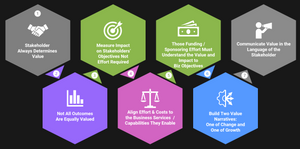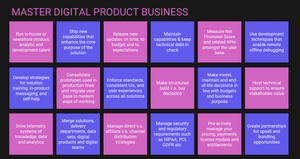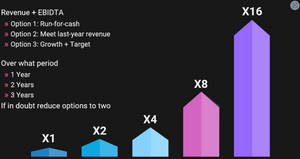Introduction
This post builds on playbooks we introduced in earlier posts that, when sequenced one after the other, help you be better at managing ideas within a Digital Business:
- Playbook 1 helps you set up a framework for idea management.
- Playbook 2 helps you be a badass at engaging stakeholders, exploring ideas and determining the customer value of work requests.
This sequencing means that by this point, we have a solid foundation to explore the potential value this work can have on your business assets:

Analysing for business value
Use this Playbook to achieve clarity around the value of work requests to your organisation in terms of:
- Business impact (revenue/productivity/efficiency).
- Options and alternatives.
- Timeliness and urgency.
- Viability of engaging in this work.

Understanding business value is a multi-dimensional operation.
It requires work to be scoped in terms of:
- Its purpose and intent
- What it enables (faster workflows, cheaper transactions, reduction in errors etc.)
- What it delays (if done before other work)
- What it depends on (resources, time, costs, investment, cross-functional work)
- What it opens up the business to (opportunity and risk)
- What it needs to be successful – Internal and external engagement (project management and cross-functional synchronisation, partner engagement, suppliers etc.)
- Strategic advantage in the short-term capabilities and return
- Strategic advantage in the longer-term capabilities and return
- Objectives and measures of success
- Urgency (Can this be delayed?)
Step 1: Frame business value by engaging expert diversity
It is a mistake to expect that a single individual fully understands and has the necessary insight to frame such context on the get-go.
When analysing work requests, it is critical to embrace the wisdom that results from a broader set of people:
| Stakeholders | Feedback dimension | Analysing work request value in terms of: |
| Executive and Leadership | Business appetite to engage in this work |
|
| Support | Customer engagement |
|
| Finance | Financial impact / considerations |
|
| Legal | Legal impact and incoming frameworks |
|
| Sales and Go-To-Market | Partner, Channel and impact to campaign strategies |
|
| Operations | Productivity impact |
|
| Delivery | Technical and Architecture impact |
|
| Business | Transformational impact |
|

Step 2: Verbosely document work requests for future reference and third-party collaboration

By analysing work requests with broader collaboration, you automatically open yourself up to a:
- Whole new level of detail and understanding.
- Multitude of ways and dimensions to evaluate business value.
"Unless this detail is adequately captured, noted and structured in time, it will be forgotten and lost."
"Beware from the bad habits of people that try to remember the context of discussions from memory or relay them purely verbally."

"Make sure to write everything down in one place."
You know you are doing this well when someone who is not you can read the brief/notes can:
- Quickly understand the request.
- Correctly express what is being asked and relay their understood customer and business value.
- Is confident to engage with stakeholders effectively without making them feel like they need to repeat discovery questions that may have already been replied to by the person who ran the initial discovery.
Use these data points to become a master at scoping work requests and framing them in terms of the business value they enable.
I talk more about the framing of value in "The Art of business value".
Step 3: Standard prioritisation
By this stage, you are in a great place.
For each work request you successfully:
- Framed the customer and business value.
- Engaged a whole range of stakeholders.
- Created an informed idea on whether this should be worked on or not.
- Determined a relative position of where this falls in the priority list.
You can stop here, and you are already in great shape.
Proceed to Steps 4 and 5 for PRO TIPS.
PRO TIPS ensures a visible method to your prioritisation madness. These PRO TIPS steps help you cement your area of expertise by helping you marry intent, data, customer value, business value and domain knowledge within your prioritisation process.
"While they can embrace occasional moments of genius, stakeholders tend to be more trusting of transparent, reliable and repeatable processes with that touch of genius."
Step 4: PRO TIP: Extend the information captured to include structured META properties
Advance your backlog management from a simple task-list mechanism to a source of continuous valuable data you can use to make decisions.
In addition to the notes, you captured from your discussions, profile the nature of the work requests. Examples with potential options include:
| Area | Options | ||
| Business Value Theme | New capability | Enhancement | Maintenance |
| Bug Fix | Customer Experience | Speed of work | |
| Systems Integration | API | Intelligence | |
| Source of Request | Customer | Marketing | Sales |
| Business | Delivery | Operations | |
| Product | Other | ||
| Type of work | New | Update | Rework |
| Depth of business case understanding of the request | High | Medium | Low |
| Depth of technical understanding of the request | High | Medium | Low |
| Urgency | High | Medium | Low |
| Business Impact | High | Medium | Low |
| Effort Expected | High | Medium | Low |
| Complexity | High | Medium | Low |
| Cost | High | Medium | Low |
| Expected number of users | High | Medium | Low |
| Expected Frequency of use | High | Medium | Low |
| Take rate | 10% | 50% | 75%+ |
| Risk | High | Medium | Low |
| Impact Area | High | Medium | Low |
"This META information is the foundation on which to build quantitative-powered analysis and prioritisation."
Step 5: PRO-TIP: Quantitative-powered prioritisation
Imagine you decided to proceed with this work request.
It would help if you now decided on where this piece of work will fall in the context of all other requests you previously recommended to proceed.
Use the META information to create a weighted pipeline of work across all of the approved items. Use this resulting weighted value to inform your priorities.

You can create separate formulas depending on whether you want to prioritise by:
- Strategic value
- Business value themes
- Commercial feasibility
- Economic gain
- Other
Given a well-calibrated weighting formula reviewed with the business stakeholders, the resulting sorting generally will not surprise you. There will be times it can, and when it does, it will help you investigate why.
Use this same information to filter, export and pivot data for historical analysis, trends, informed decision making, and cross-functional team engagement.
Wrapping up
Making decisions that impact a broad group of stakeholders requires skills and intent to manage like a pro. We explored how to build an understanding of customer value and business value by engaging the right people.
We also explored ways to ensure they support your methodologies by making them feel:
- Listened to
- Valued
- Involved
- Engaged and Communicated with
- Supported by a system that reduces personal bias
This level of transparency and formulaic approach to work evaluation helps:
- Offset any instinctual or emotional biases.
- De-risk heavier investments.
- Eliminate friction.
- Get support from the broader business to engage in this cost.
- Garner board support for the work you are doing, and how.
Equipped with this you are now able to expertly map work requests to actual BUSINESS VALUE and impact!. Go go go!







